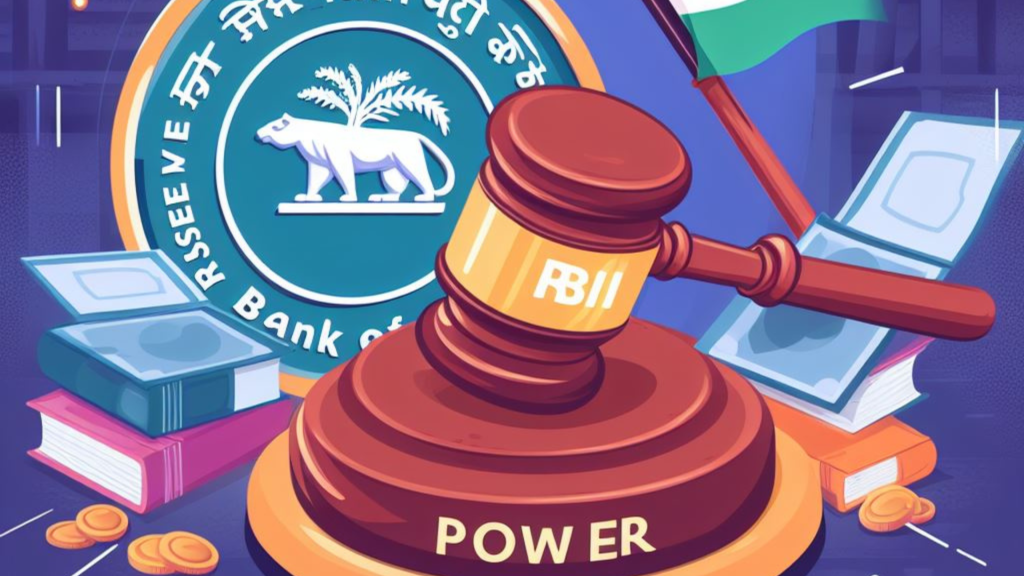Powers of RBI : The Reserve Bank of India (RBI) wields substantial authority through the RBI Act and the Banking Regulation Act, enabling it to oversee and regulate a diverse range of banks operating in India. This section provides a concise overview of the pivotal powers held by the RBI:

Powers of RBI
Powers Under Banking Regulation Act: The Banking Regulation Act empowers the RBI with a variety of authorities, including:
- Section 10 BB – Appointment of Chairman or Managing Director: When the post of Chairman of the Board of Directors or Managing Director of a banking company is vacant, the RBI can appoint an individual to ensure the company’s smooth functioning.
- Section 21 – Control of Advances: The RBI can establish policies and direct banking companies to adhere to them, thereby regulating advances made by these institutions.
- Section 22 – Licensing of Banking Companies: All banking companies must obtain a license from the RBI, which is issued only after fulfilling entry requirements.
- Section 24A – Exemption of Cooperative Banks: The RBI can, through an official notification, exempt co-operative banks from specific provisions of the Act.
- Section 27 – Reporting and Information Gathering: The RBI is authorized to request statements and information from banking companies, even beyond the regular half-yearly updates, to assess their operations and compliance.
- Section 29A – Oversight of Associate Enterprises: The RBI may require banking companies to furnish statements and information related to their associate enterprises. It also has the authority to conduct joint inspections with the relevant regulatory authority regarding these associates.
- Section 30 – Special Audit: The RBI can order a special audit of a banking company’s accounts in the public interest or to protect the interests of the bank and its depositors.
- Section 35 – Inspection: The RBI, independently or upon direction by the Central Government, can inspect any banking company and its books, providing the company with a copy of the inspection report.
- Section 35A – Directive Powers: In the interest of the public or banking policy, the RBI has the authority to issue, modify, or cancel directions that must be followed by banking companies.
- Section 36 – Additional Functions: The RBI can caution or prohibit banking companies from specific transactions, assist in amalgamations, provide financial assistance, call for meetings of directors, appoint observers, furnish information, and make management changes.
- Section 36AA – Removal of Persons from Office: The RBI can remove managerial and other individuals from office.
- Section 36AB – Appointment of Additional Directors: The RBI has the power to appoint additional directors.
- Section 35AB – Directions on Stressed Assets: The RBI can issue directions concerning stressed assets.
- Section 36ACA – Superseding Board of Directors: The RBI can supersede the board of directors in certain cases.
- Section 36AAA – Superseding Board of Directors of Multi-State Co-operative Banks: The RBI can supersede the board of directors of multi-State co-operative banks.
- Section 47 – Imposition of Penalties: The RBI is authorized to impose penalties as necessary.
These powers empower the RBI to effectively regulate and manage the banking sector in India, ensuring stability and compliance within the industry.
| S.no | Power | Section | Emoji |
|---|---|---|---|
| 1 | Power of direct discount. | 18 | 💲 |
| 2 | Power to require returns from co-operative banks. | 44 | 📋 |
| 3 | Power to collect credit information. | 45B | 💳 |
| 4 | Power to call for returns containing credit information. | 45C | 📊 |
| 5 | Power to determine policy and issue directions. | 45JA | 📜 |
| 6 | Power to call for information from financial institutions and to give directions. | 45L | 📈 |
| 7 | Power to regulate transactions in derivatives (excluding capital market derivatives), money market instruments. | 45W | 💱 |
| 8 | Power of Bank to depute its employees to other institutions. | 54AA | 👥 |
| 9 | Power of the (RBI’s) Central Board to make regulations. | 📜 |
Powers of RBI FAQ
The RBI is responsible for regulating and controlling the monetary and credit systems in India. Its main functions include issuing currency, managing foreign exchange reserves, and regulating the banking sector.
RBI formulates and implements India’s monetary policy. It sets key policy rates like the repo rate, reverse repo rate, and the cash reserve ratio (CRR) to control inflation and support economic growth.
RBI regulates and supervises banks and financial institutions to ensure their stability and integrity. It grants licenses, monitors compliance, and takes corrective actions when necessary.
Yes, RBI manages India’s foreign exchange reserves and intervenes in foreign exchange markets to stabilize the rupee’s exchange rate.
Yes, RBI is the sole authority to issue currency notes in India, except for one-rupee notes and coins issued by the Government of India.